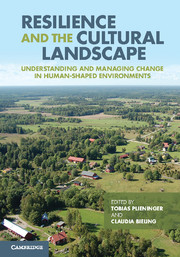 Resilience and the Cultural Landscape
Resilience and the Cultural Landscape Book contents
- Frontmatter
- Contents
- List of contributors
- Preface
- Part I Conceptualising landscapes as social–ecological systems
- Part II Analysing landscape resilience
- 7 In search of resilient behaviour: using the driving forces framework to study cultural landscapes
- 8 Cultural landscapes as complex adaptive systems: the cases of northern Spain and northern Argentina
- 9 Linking path dependency and resilience for the analysis of landscape development
- 10 The sugar-cane landscape of the Caribbean islands: resilience, adaptation and transformation of the plantation social–ecological system
- 11 Offshore wind farming on Germany’s North Sea coast: tracing regime shifts across scales
- Part III Managing landscapes for resilience
- Part IV Perspectives for resilient landscapes
- Index
- References
9 - Linking path dependency and resilience for the analysis of landscape development
Published online by Cambridge University Press: 05 November 2012
- Frontmatter
- Contents
- List of contributors
- Preface
- Part I Conceptualising landscapes as social–ecological systems
- Part II Analysing landscape resilience
- 7 In search of resilient behaviour: using the driving forces framework to study cultural landscapes
- 8 Cultural landscapes as complex adaptive systems: the cases of northern Spain and northern Argentina
- 9 Linking path dependency and resilience for the analysis of landscape development
- 10 The sugar-cane landscape of the Caribbean islands: resilience, adaptation and transformation of the plantation social–ecological system
- 11 Offshore wind farming on Germany’s North Sea coast: tracing regime shifts across scales
- Part III Managing landscapes for resilience
- Part IV Perspectives for resilient landscapes
- Index
- References
Summary
Introduction
This chapter explores the usefulness of adopting the social science approach of path dependency to understand the social–ecological resilience of cultural landscape, its historical roots and the resulting capacity to adapt to new challenges. Drawing on the cultural landscapes approach of Jones (2003) and aspects of institutionalism, human activities can be seen to be influenced by several institutional systems (e.g. nature conservation, agriculture or tourism). These consist of rules and regulations (formal institutions) as well as norms and moral concepts (informal institutions), with different goals, logics of action and notions of cultural landscape (Gailing & Röhring, 2008). It is argued that cultural landscapes cannot be defined only in terms of their physical dimensions (natural structures, historical and actual land use structures). They are also social constructions based on subjective perspectives on the landscape and shaped by informal institutions such as spatial images, local narratives or traditions (Gailing, 2010). In terms of governance arrangements, cultural landscapes can be constituted as collective action areas such as biosphere reserves, regional parks or tourism regions (Fürst et al., 2008). The institutional configuration and social construction of cultural landscapes has consequences for the refinement of the resilience perspective of Walker et al. (2006). Each group of stakeholders constructs different notions of resilience depending on their specific, historically rooted ways of dealing with or constructing cultural landscapes; thus, there is no generally accepted ‘resilience of what to what’ (Carpenter et al., 2001). We assume that this question can only be answered if a specifically institutional perspective is adopted, one with an emphasis on historical and regional factors. Therefore, the key concern of our chapter is how physical and institutional path dependencies influence the varying constructions of resilient cultural landscapes.
In the first section, we introduce the path dependency approach and then compare it to the social–ecological resilience concept. Next, comparative case studies of the rural floodplain landscapes Oderbruch and Spreewald in the German state of Brandenburg are presented. In particular, the impacts of physical and institutional path dependencies on the resilience of cultural landscapes (as complex social–ecological constructs) are assessed. The chapter concludes with a comparative analysis of the case study findings and an outline of proposals for linking the concept of resilience and the path dependency approach in future research on cultural landscapes.
- Type
- Chapter
- Information
- Resilience and the Cultural LandscapeUnderstanding and Managing Change in Human-Shaped Environments, pp. 146 - 163Publisher: Cambridge University PressPrint publication year: 2012
References
- 5
- Cited by
